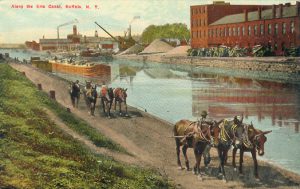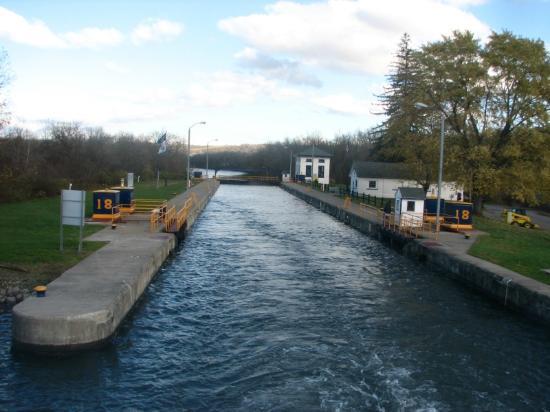 As many readers will already know, when I am not immersed in genealogy I am probably doing something that involves reading about, watching, studying, or writing about hockey. Such was the case this past weekend, as I traveled by car from Boston to Buffalo, New York, for the annual Combine – a grueling physical fitness testing day for hockey prospects in preparation for the NHL draft at the end of June.
As many readers will already know, when I am not immersed in genealogy I am probably doing something that involves reading about, watching, studying, or writing about hockey. Such was the case this past weekend, as I traveled by car from Boston to Buffalo, New York, for the annual Combine – a grueling physical fitness testing day for hockey prospects in preparation for the NHL draft at the end of June.
The drive, according to Google Maps, was to take approximately 6½ hours; it took closer to eight. Now, since I lived in Central Florida for many years, such a drive was not daunting to me as I was used to it taking 8 hours to get either to the Keys in southern Florida or to the border with Georgia to the north. However, in my typical tunnel vision, it wasn’t until I had hit Albany and was heading west in New York that I remembered that I would be traveling in the same direction as the Erie Canal.
 As I drove along on I-90, I began to look to my right and noticed the flowing waters of the Erie Canal in certain places. It took me back to a time when I was creating a lecture on Midwest migration and the history of the Erie Canal came pouring into my head. I even noticed some of the locks – those areas used to change elevation by adding or eliminating water, allowing boats to continue along the waterway at a new water level – which is something I was familiar with from my boating days in Florida.
As I drove along on I-90, I began to look to my right and noticed the flowing waters of the Erie Canal in certain places. It took me back to a time when I was creating a lecture on Midwest migration and the history of the Erie Canal came pouring into my head. I even noticed some of the locks – those areas used to change elevation by adding or eliminating water, allowing boats to continue along the waterway at a new water level – which is something I was familiar with from my boating days in Florida.
As I continued on my way the names of towns came and went; again I was Buffalo bound in my mind. However, my mind was instantly snapped back to genealogy as I saw a sign for the town of Ilion, New York – home to Eliphalet Remington and his sons. Makers of the Remington rifle, the Remington typewriter, and a sewing machine, I knew this family well from researching them at NEHGS. In fact, at one time the town was called Remington, but Eliphalet did not want it named after him. I confess I had a momentary “star struck” moment as I realized how close I was to someone who had done so much.
Then it hit me how often we drive to and fro and probably go zipping past places where our ancestors lived or fought in a battle. I couldn’t stop at these places, but for a moment, as I saw the Erie Canal from the car, I could appreciate the importance of that waterway in connecting the state of New York and offering a method of migration. I could also marvel at how the past and the present were almost touching. As I zipped along on an interstate at a speedy 65 miles per hour, I was sure that those who meandered on the canal at one time marveled at how much faster and smoother their travel on the canal was in comparison to travel by horse and wagon on the surrounding ground. As I went through various tolls, I thought about the tolls on the Erie Canal and how when it was first built the expected money earned was quickly overshadowed by the actual revenue collected on the Canal.
Road trips usually include stops at family homesteads, cemeteries, and courthouses. But even if a stop isn’t an option, you may still be able to embrace the history of an area and call to mind research you have done in the past.
Oh, I do so believe that the canal can talk! What stories westward! Great post.
I grew up along the canal, in Lockport, so it’s a big part of my immediate family history. My ancestors, though, came from Plymouth and Boston west to the Hudson and then south to Pennsylvania. I never drive to visit my daughter in Boston without thinking about all of them.
My mother’ family was from Western NY, so the Erie Canal was always a familiar subject. When I learned an ancestor’s brother had worked on it, I immediately began searching all the NY towns through which it ran: census records, etc. imGine my surprise to learn there was an Erie Extension Canal that ran from Erie PA to the Ohio River…and that’s where I found him-near the other Erie Canal.
Having come from Connecticut I knew little about the Erie Canal other than its use for moving goods and its place in history. When I began following some ancestors’ descendants from Connecticut to Oneida, New York I saw one of them working to build the canal and fully realized that it was many things to people, not the least a means of work and income, but a pathway for others to follow them. The canal allowed them to farm and transport meat and produce back to NYC without contending with the poor roads of the time. Later it allowed others to go farther west. All that from one watery pathway!
Many people on both sides of my family lived in Central New York and emigrated in the 1800s to southern Michigan and Northern Ohio. I’m sure they took the Erie Canal
. I read a story about two Rorick brothers from the same area (Chemung and Steuben counties), one who went west on the canal and the other traveled by land. I’m sure the canal traveler had a much better trip.
Maybe you could’ve planned ahead and taken the slow boat to Buffalo. I would love to do that someday.
In most cases the travel was, I believe by oxcart and on foot, before the canal. And quite often done in winter when the frozen ground was firmer than all the mud and swamps.
Hi Rhonda..I made the same trip last summer. Flew to Boston to visit my sister in NH and a godson in Arlington and the NEHGS Library and BPL. Then drove to Buffalo taking 4 days, stopping to play Donald Ross golf courses along the way, and visit my best man in Cazanovia. Drove mostly Rte 20 which parallels the Thruway and passes through many of the old towns. Got to Buffalo to meet my wife coming from our home in San Jose to her family’s reunion. Lots of genealogy stuff in that. We’ve lived in Schenectady and Albany in addition to Buffalo where we met 52 years ago. Did you visit the restored Erie Canal end in downtown Buffalo?
Like you hockey is my entertainment game. Sharks ticket holder since day one. Once a Buffalo fan and as a child a Bruins fan. Much sadness now at the pending defeat in Cup finals.
Fun article..keep up the good work.
During the summer of 1965, my parents rented a cabin cruiser and one trip was on the Erie Canal. My brother and I met them one night and traveled westward for a day (my mother drove my car). The next day it took my brother and I one hour on the NY Thruway to travel the miles of the previous days travel and that had not been at the speed of mules.
I know live in Akron OH so the Ohio-Erie Canal, or at least what is left of it, is visible throughout the area.
I knew my ancestors were from Vienna, Oneida County, New York, but until I visited there I did not realize how much impact the Canal would have had on their lives. As weavers, their fabric would have been shipped on the canal. The family cemetery is near where the canal flows into Lake Oneida. I suspect that they took it to Buffalo and took the lake route when the moved west to Illinois as Grundy County is close to Lake Michigan.
Was there a canal across from Lake Erie to Illinois? Or did they go by land across Indiana. Lake Erie is not a happy place to be in a storm.
I hope you got to see more of Buffalo than the manufactured history downtown, we have so much more.
It is so true that many of our quick trips follow the modern roads that mirror our ancestors treks. It is great when we can take the time to explorer and duplicate their travels and see the area as they did.
The Erie Canal flowed past my backyard for 25 years, but I didn’t know until working on genealogy that 2 of my mother’s ancestors DIED/DROWNED while working on the canal.